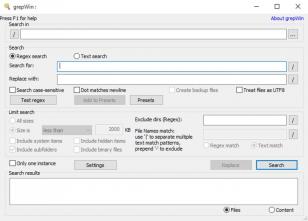


Īlternatively, you can do recursive globbing in your shell. grep -R -include='LYFNRE.*' -f file1.txt -H. GNU grep and recent BSD implementations (including OSX) support options to call grep recursively without requiring find. This also shortens the time taken for the search to complete by a considerable duration. For example, if you want to search for all files inside C:folder which contain the text something to search for and have a file extension of. GrepWin could list a ton of files, and if you have trouble finding the one you wanted, I recommend playing around with the Limit Search settings to restrict the process by file size, date, hidden, system or binary files, disabling recursive search (subfolders). You can also limit that search to files of a certain type. regex: yesno sets whether the /searchfor text is a regex or normal text, default is regex. You can use PowerShell to search for certain text in files in a given folder and its subfolders. Some grep implementations have an option for that: -H.Īdditionally, you can use -exec … + stores ini settings file in the same directory as the one in which grepwin.exe resides. When grep sees a single file on its command line, it assumes that you know exactly where you'r searching, so it doesn't display the file name in front of matches.Ī trick to force grep to always output a file name is to also pass /dev/null (where there won't be any match ever). you can use sections to specifiy different sets of commands. The macro prompts you each time it finds a file name or folder with the text string you are looking for and ask if you want to rename it. Select a folder, press with left mouse button on OK. In the next dialog box, type a text sting you want to replace it with. specifies an ini file which contains all the values usually passed on the command line. Type a text string you want to find in the dialog box. The problem is that you're passing one file at a time to grep. stores ini settings file in the same directory as the one in which grepwin.exe resides.


 0 kommentar(er)
0 kommentar(er)
